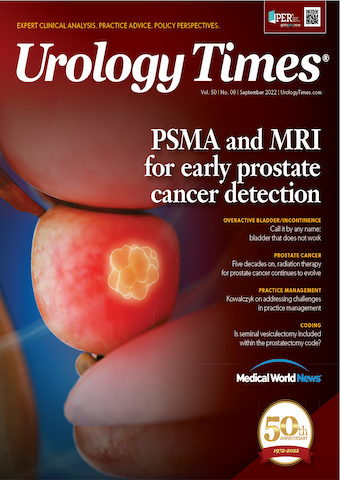Publication
Article
Urology Times Journal
Do 5-ARIs protect against death from prostate cancer?
Author(s):
"It is evident...that the safety of 5-ARIs as it relates to prostate cancer outcomes is contingent upon the clinician understanding its effect on PSA level and making appropriate adjustments to ensure timely deployment of diagnostic imaging and biopsy," writes Badar M. Mian, MD.
Badar M. Mian, MD

The effect of 5-α-reductase inhibitors (5-ARIs) such as finasteride (Proscar) and dutasteride (Avodart) on prostate cancer–related outcomes has been hotly debated for almost 2 decades. The initial cause for debate arose from data from 2 clinical trials of 5-ARIs for chemoprevention of prostate cancer (PCPT and REDUCE [NCT00056407]), which showed a reduction in the risk of a prostate cancer diagnosis, but an increased incidence of high-risk prostate cancer. Further, observational studies have demonstrated conflicting results on the association between 5-ARI use and prostate cancer–specific mortality (PCSM).
In a recent population-based study, Björnebo et al investigated the association of treatment with 5-ARIs with PCSM in a large cohort of men receiving 5-ARIs for lower urinary tract symptoms (LUTS).1 This study from Stockholm, Sweden was conducted between January 1, 2007, and December 31, 2018, and included 429,977 men who had a prostate-specific antigen (PSA) test within the study period. Investigators linked multiple large registries including the Stockholm PSA and Biopsy Register, National Prostate Cancer Register of Sweden, Prescribed Drug Register, Swedish Cause of Death Register, and others. Only men without a previous prostate cancer diagnosis could enter the study. Men with prior transurethral resection of the prostate or treatment with a 5-ARI before their first PSA test were excluded. A minimum of 1.5 years between the start of 5-ARI treatment and first PSA test was required. A PSA level of 3 ng/mL or greater was considered elevated, and the PSA level was doubled if a 5-ARI had been used for at least 3 months.
Of the final cohort of 349,152 men, 26,190 were 5-ARI recipients with at least 2 filled prescriptions during follow-up. Median follow-up time was 8.2 years. The median exposure to 5-ARI was 4.5 years (interquartile range, 2.1-7.4). Men exposed to a 5-ARI during the study period were older, more likely to have had a previous negative biopsy, and had higher PSA levels than men not exposed to a 5-ARI. Prostate cancer was diagnosed in 1377 (0.4%) and 14,804 men (4.2%) with and without 5-ARI exposure, respectively. The exposed group also had a larger prostate volume, higher Gleason score, and higher primary tumor, lymph node, and metastases stage at diagnosis. A total of 35,767 patients (10.2%) died during follow-up, with 852 deaths attributed to prostate cancer.
Multivariable Cox regression demonstrated no difference in all-cause mortality for any duration of 5-ARI exposure (<2 years adjusted HR, 0.99; >8 years adjusted HR, 0.97). However, use of a 5-ARI was associated with a decrease in PCSM with longer exposure (<2.0 years adjusted HR, 0.89 vs >8 years adjusted HR, 0.44 [adjusted HR difference, 0.50]). Men treated with a 5-ARI had more PSA tests per year (median, 0.63 vs 0.33) and more biopsies per year (median, 0.22 vs 0.12) than the unexposed group. The time from elevated PSA levels to prostate biopsy was shorter in men treated with a 5-ARI than the unexposed group (median, 1.17 vs 1.20 years).
The study investigators found a decreased risk of dying of prostate cancer in men treated for LUTS with 5-ARI for more than 2 years compared with men not treated with a 5-ARI. These results suggest the safety of 5-ARI treatment and that the increased grade and stage of prostate cancer at diagnosis for men receiving 5-ARI treatment are not associated with increased PCSM.
Men receiving treatment with a 5-ARI had significantly higher diagnostic activity, with more PSA tests and prostate biopsies per year than nonrecipients of 5-ARI.
Data from previous studies on the use of 5-ARIs have shown a significantly lower diagnostic activity and prolonged time to prostate biopsy in those receiving treatment with a 5-ARI (median, 3.60 vs 1.40 years) in a cohort of men within the Veterans Affairs health care system.2 They also showed an increased PCSM that was associated with 5-ARI (adjusted HR, 1.39; 95% Cl, 1.27-1.52), which was likely related to inappropriate accounting for the effect of 5-ARI on PSA levels, with delays in diagnosis and treatment, resulting in worse PCSM. A possible explanation for the observed differences in the current study population may be that men receiving a 5-ARI had more frequent contact with urologists, with more frequent PSA tests and biopsies. The increased surveillance of men receiving treatment with 5-ARIs could explain the observed decrease in PCSM in this cohort.
It is important to consider the findings from various studies of 5-ARI effect on prostate cancer–related outcomes in light of the range of questions addressed by those studies such as incidence or detection rate, grade of cancer, and effect on PCSM and overall mortality. Similarly, the distinct features of the health care system and study population should be considered when comparing the results of those studies, as differences in clinical management and diagnostic activity may explain the disparate results.
The question remains whether the prostate cancer–related outcomes from the use of 5-ARIs are due to an effect on cancer biology or some other factors related to clinical practice. As the authors point out, it cannot be determined whether this is a causal relationship or a result of detection bias resulting from a more intensified diagnostic activity (more PSA tests, more biopsies, earlier biopsies) in the 5-ARI group. Could a similarly intensive diagnostic activity in the group without 5-ARI result in similar outcomes?
It is also worth remembering that treatment with a 5-ARI is not the same as taking the drug for chemoprevention. Most studies on this subject include men receiving 5-ARI for treatment of LUTS. Whether the results of those studies can be extrapolated to a chemoprevention paradigm, in asymptomatic men who otherwise had no clinical reason to use a 5-ARI, remains unclear. Findings from most, but not all, observational studies suggest that despite the increased incidence of high-grade prostate cancer associated with 5-ARI usage, it is not associated with worse prostate cancer–related mortality. It is evident, however, that the safety of 5-ARIs as it relates to prostate cancer outcomes is contingent upon the clinician understanding its effect on PSA level and making appropriate adjustments to ensure timely deployment of diagnostic imaging and biopsy.
References
1. Björnebo L, Nordström T, Discacciati A, et al. Association of 5α-reductase inhibitors with prostate cancer mortality. JAMA Oncol. 2022;8(7):1019-1026. doi:10.1001/jamaoncol.2022.1501
2. Mian BM. What do recent studies tell us about finasteride and PCa? Urology Times®. December 5, 2019. Accessed August 8, 2022. https://bit.ly/3Q8aRpx
























